Kansai International Airport
| Kansai International Airport 関西国際空港 Kansai Kokusai Kūkō | |||||||||||||||
|---|---|---|---|---|---|---|---|---|---|---|---|---|---|---|---|
 | |||||||||||||||
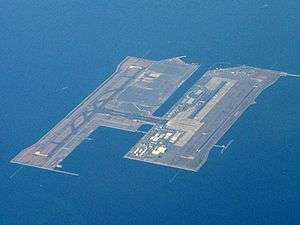 | |||||||||||||||
|
IATA: KIX – ICAO: RJBB – WMO: 47774 | |||||||||||||||
| Summary | |||||||||||||||
| Airport type | Public | ||||||||||||||
| Operator | Kansai Airports[1] | ||||||||||||||
| Serves | Greater Osaka Area | ||||||||||||||
| Location |
Izumisano, Sennan, & Tajiri Osaka, Japan | ||||||||||||||
| Hub for | |||||||||||||||
| Elevation AMSL | 5 m / 17 ft | ||||||||||||||
| Coordinates | 34°26′03″N 135°13′58″E / 34.43417°N 135.23278°ECoordinates: 34°26′03″N 135°13′58″E / 34.43417°N 135.23278°E | ||||||||||||||
| Website |
www | ||||||||||||||
| Map | |||||||||||||||
 KIX RJBB Location in Japan | |||||||||||||||
| Runways | |||||||||||||||
| |||||||||||||||
| Statistics (2015) | |||||||||||||||
| |||||||||||||||
|
Statistics from New Kansai International Airport Company, Ltd.[3] | |||||||||||||||
Kansai International Airport (関西国際空港 Kansai Kokusai Kūkō) (IATA: KIX, ICAO: RJBB) is an international airport located on an artificial island in the middle of Osaka Bay, 38 km (24 mi) southwest of Ōsaka Station,[4] located within three municipalities, including Izumisano (north),[5] Sennan (south),[6] and Tajiri (central),[7] in Osaka Prefecture, Japan. The airport is off the Honshu shore and was designed by Italian architect Renzo Piano. The airport serves as an international hub for All Nippon Airways, Japan Airlines, and Nippon Cargo Airlines, and also serves as a hub for Peach, the first international low-cost carrier in Japan.
It is colloquially known as Kankū (関空) in Japanese.
Kansai opened 4 September 1994 to relieve overcrowding at Osaka International Airport, which is closer to the city of Osaka and now handles only domestic flights. During the 2006 fiscal year, KIX had 116,475 aircraft movements, of which 73,860 were international (31 countries, 71 cities), and 42,615 were domestic (19 cities). The total number of passengers was 16,689,658 of which 11,229,444 were international, and 5,460,214 were domestic, sixth in Japan and second in Osaka area. However, in 2009, airport traffic has fallen by almost 20% in just two years to 13.4 million.[8] In 2010 airport traffic had risen to over 14 million, with international passengers accounting for approximately 10.4 million and domestic passengers accounting for approximately 3.7 million.[9] Freight volume was at 802,162 tonnes total, of which 757,414 t were international (18th in the world), and 44,748 t were domestic.[10] The 4,000 m × 60 m (13,123 ft × 197 ft) second runway was opened on 2 August 2007. As of June 2014, Kansai Airport has become an Asian hub, with 780 weekly flights to Asia and Australasia (including freight 119), 59 weekly flights to Europe and the Middle East (freight 5), and 80 weekly flights to North America (freight 42).[11]
History
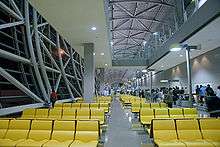
In the 1960s, when the Kansai region was rapidly losing trade to Tokyo, planners proposed a new airport near Kobe and Osaka. Osaka International Airport, located in the densely populated suburbs of Itami and Toyonaka, was surrounded by buildings; it could not be expanded, and many of its neighbours had filed complaints because of noise pollution problems.
After the protests surrounding New Tokyo International Airport (now Narita International Airport), which was built with expropriated land in a rural part of Chiba Prefecture, planners decided to build the airport offshore. The new airport was part of a number of new developments to revitalize Osaka, which had been losing economic and cultural ground to Tokyo for most of the century.[12]
Initially, the airport was planned to be built near Kobe, but the city of Kobe refused the plan, so the airport was moved to a more southerly location on Osaka Bay. There it could be open 24 hours per day, unlike its predecessor in the city.
Construction
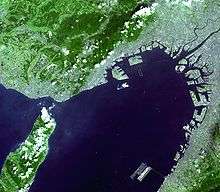

An artificial island, 4 km (2.5 mi) long and 2.5 km (1.6 mi) wide, was proposed. Engineers needed to overcome the extremely high risks of earthquakes and typhoons (with storm surges of up to 3 m (10 ft)).
Construction started in 1987. The sea wall was finished in 1989 (made of rock and 48,000 tetrapods). Three mountains were excavated for 21,000,000 m3 (27,000,000 cu yd) of landfill. 10 000 workers and 10 million work hours over three years, using eighty ships, were needed to complete the 30-metre (98 ft) layer of earth over the sea floor and inside the sea wall. In 1990, a three kilometer bridge was completed to connect the island to the mainland at Rinku Town, at a cost of $1 billion. Completion of the artificial island increased the area of Osaka Prefecture just enough to move it past Kagawa Prefecture in size (leaving Kagawa as the smallest by area in Japan).
The bidding and construction of the airport was a source of international trade friction during the late 1980s and early 1990s. Prime Minister Yasuhiro Nakasone responded to American concerns, particularly from Senator Frank Murkowski, that bids would be rigged in Japanese companies' favour by providing special offices for prospective international contractors,[13] which ultimately did little to ease the participation of foreign contractors in the bidding process.[14] Later, foreign airlines complained that two-thirds of the departure hall counter space had been allocated to Japanese carriers, disproportionately to the actual carriage of passengers through the airport.[15]
The island had been predicted to sink 5.7 m (19 ft) by the most optimistic estimate as the weight of the material used for construction compressed the seabed silts. However, by 1999, the island had sunk 8.2 m (27 ft) – much more than predicted. The project became the most expensive civil works project in modern history after twenty years of planning, three years of construction and fifteen billion (US) dollars of investment. Much of what was learned went into the successful artificial islands in silt deposits for New Kitakyushu Airport, Kobe Airport, and Chūbu Centrair International Airport. The lessons of Kansai Airport were also applied in the construction of Hong Kong International Airport.[16]
In 1991, the terminal construction commenced. To compensate for the sinking of the island, adjustable columns were designed to support the terminal building. These are extended by inserting thick metal plates at their bases. Government officials proposed reducing the length of the terminal to cut costs, but architect Renzo Piano insisted on keeping the terminal at its full planned length.[17] The airport opened in 1994.
On 17 January 1995, Japan was struck by the Kobe earthquake, whose epicenter was about 20 km (12 mi) away from KIX and killed 6,434 people on Japan's main island of Honshū. Due to its earthquake engineering, the airport emerged unscathed, mostly due to the use of sliding joints. Even the glass in the windows remained intact. In 1998, the airport survived a typhoon with wind speeds of up to 200 km/h (120 mph).
On 19 April 2001, the airport was one of ten structures given the "Civil Engineering Monument of the Millennium" award by the American Society of Civil Engineers.[18]
As of 2008, the total cost of Kansai Airport was $20 billion including land reclamation, two runways, terminals and facilities. Most additional costs were initially due to the island sinking, expected due to the soft soils of Osaka Bay. After construction the rate of sinking was considered so severe that the airport was widely criticized as a geotechnical engineering disaster. The sink rate fell from 50 cm (20 in) per year during 1994 to 7 cm (2.8 in) per year in 2008.[19]
Operation


Opened on 4 September 1994, the airport serves as a hub for several airlines such as All Nippon Airways, Japan Airlines, and Nippon Cargo Airlines. It is the international gateway for Japan's Kansai region, which contains the major cities of Kyoto, Kobe, and Osaka. Other Kansai domestic flights fly from the older but more conveniently located Osaka International Airport in Itami, or from the newer Kobe Airport.
The airport had been deeply in debt, losing $560 million in interest every year. Airlines had been kept away by high landing fees (about $7,500 for a Boeing 747), the second most expensive in the world after Narita's. In the early years of the airport's operation, excessive terminal rent and utility bills for on-site concessions also drove up operating costs: some estimates before opening held that a cup of coffee would have to cost US$10.[20] Osaka business owners pressed the government to take a greater burden of the construction cost to keep the airport attractive to passengers and airlines.[21]
On 17 February 2005, Chubu Centrair International Airport opened in Nagoya, just east of Osaka. The opening of the airport was expected to increase competition between Japan's international airports. Despite this, passenger totals were up 11% in 2005 over 2004, and international passengers increased to 3.06 million in 2006, up 10% over 2005. Adding to the competition was the opening of Kobe Airport, less than 25 km (16 mi) away, in 2006 and the lengthening of the runway at Tokushima Airport in Shikoku in 2007. The main rationale behind the expansions was to compete with Incheon International Airport and Hong Kong International Airport as a gateway to Asia, as Tokyo area airports were severely congested. Kansai saw an 5% year-on-year increase in international traffic in summer 2013, largely supported by low-cost carrier traffic to Taiwan and Southeast Asia overcoming a decrease in traffic to China and South Korea.[22]
The airport authority was allotted 4 billion yen in government support for fiscal year 2013, and the Ministry of Land, Infrastructure and Transport and Ministry of Finance have agreed to reduce this amount in stages through fiscal year 2015, although local governments in the Kansai region have pressed for continued subsidies.[23]
Kansai has been marketed as an alternative to Narita Airport for international travelers from the Greater Tokyo Area. By flying to Kansai from Haneda Airport and connecting to international flights there, travelers can save the additional time required to get to Narita: up to one and a half hours for many residents of Kanagawa Prefecture and southern Tokyo.
Expansion
The airport was at its limit during peak times, owing especially to freight flights, so a portion of Phase II expansion—the second runway—was made a priority.[24] Thus, in 2003, believing that the sinking problem was almost over, the airport operators started to construct a 4,000 m (13,000 ft) second runway and terminal.
The second runway opened on 2 August 2007, but with the originally planned terminal portion postponed. This lowered the project cost to JPY¥910 billion (approx. US$8 billion), saving ¥650 billion from the first estimate.[25] The additional runway development, which was opened in time for the IAAF world athletics championships in Osaka, has expanded the airport size to 10.5 square kilometres (2,600 acres). The second runway is used for landings and when there are incidents prohibiting take off use of runway A. The new runway allowed the airport to start 24-hour operations in September 2007.[26][27]
A new terminal building opened in late 2012.[28] There are additional plans for several new aprons, a third runway (06C/24C) with a length of 3,500 m (11,483 ft), a new cargo terminal and expanding the airport size to 13 km2 (5.0 sq mi). As of 2012, the Japanese government is postponing these plans for economic reasons.
Relationship with Itami Airport
Since July 2008, Osaka Prefecture governor Toru Hashimoto has been a vocal critic of Itami Airport, arguing that the Chuo Shinkansen maglev line will make much of its domestic role irrelevant, and that its domestic functions should be transferred to Kansai Airport in conjunction with upgraded high-speed access to Kansai from central Osaka.[29] In 2009, Hashimoto also publicly proposed moving the functions of Marine Corps Air Station Futenma to Kansai Airport as a possible solution for the political crisis surrounding the base.[30]
In May 2011, the Diet of Japan passed legislation to form a new Kansai International Airport Corporation using the state's existing equity stake in Kansai Airport and its property holdings at Itami Airport. The move was aimed at offsetting Kansai Airport's debt burden.[31]
The merger of the Itami and Kansai airport authorities was completed in July 2012. Shortly following the merger, Kansai Airport announced a 5% reduction in landing fees effective October 2012, with additional reductions during overnight hours when the airport is underutilized, and further discounts planned for the future, including subsidies for new airlines and routes. As of October 2012 these moves were intended to bring Kansai's fees closer to the level of Narita International Airport, where landing fees were around 20% lower than Kansai's, and to improve competitiveness with other Asian hubs such as Incheon International Airport in Korea.[32]
Since its formation, the new operating company has also made efforts toward international expansion, bidding for operating concessions at Yangon International Airport and Hanthawaddy International Airport in Myanmar.[33]
KIAC conducted a public tender to sell the operating rights for Kansai and Itami Airport in May 2015. Orix and Vinci SA were the sole bidder for the 45-year contract, at a price of around $18 billion.[34] The new operating company will be formed around the end of 2015 and will be 80% owned by Orix and Vinci, with the remaining 20% owned by Kansai-based enterprises such as Hankyu Hanshin Holdings and Panasonic.[35]
Terminals
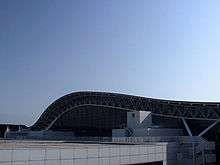
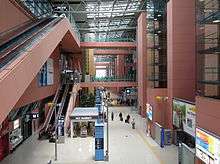
Terminal 1
The main KIX passenger Terminal l is a single four-story building designed by Renzo Piano Building Workshop (Renzo Piano and Noriaki Okabe) and has a gross floor space of 296,043 square metres (3,186,580 sq ft). As of 2008, it is the longest airport terminal in the world, at a total length of 1.7 km (1.1 mi) from end to end. It has a sophisticated people mover system called the Wing Shuttle, which moves passengers from one end of the pier to the other.
The terminal's roof is shaped like an airfoil. This shape is used to promote air circulation through the building: giant air conditioning ducts blow air upwards at one side of the terminal, circulate the air across the curvature of the ceiling, and collect the air through intakes at the other side. Mobiles are suspended in the ticketing hall to take advantage of the flowing air.
The ticketing hall overlooks the international departures concourse, and the two are separated by a glass partition. During Kansai's early days, visitors were known to throw objects over the partition to friends in the corridor below. The partition was eventually modified to halt this practice.
Terminal 2

Terminal 2 is a low-cost carrier (LCC) terminal designed to attract more LCCs by providing lower landing fees than terminal 1. It is exclusively occupied by Peach. Other LCCs serving Kansai, such as Jetstar Airways, Jetstar Japan, and Cebu Pacific Air, use the main Terminal 1, but there are plans to build a third terminal to house other LCCs.[36]
Peach requested that Terminal 2 have a simplified design in order to minimize operating costs.[37] The terminal is a single-story building, thus eliminating the cost of elevators. Passageways to aircraft have no air conditioning.[38] The terminal also has no jet bridges, having one boarding gate for domestic departures and one boarding gate for international departures. In case of rain, passengers are lent umbrellas to use as they walk to the aircraft.[39]
Terminal 2 is not directly connected to Terminal 1 or to Kansai Airport Station. Free shuttle buses run between the two terminals, and between Terminal 2 and the railway and ferry stations. It is also possible to walk between the terminals through the KIX Sora Park, a four-hectare park located adjacent to Terminal 2.[40]
Terminal 3 (planned)
Kansai Airport plans to build a third terminal for use by low-cost carriers (excluding Peach, primarily Jetstar Airways, Jetstar Japan and other group companies. NKIAC plans to finalize the terminal plan during fiscal year 2014–15 and commence construction during fiscal year 2015–16.[41] The terminal is scheduled to open by March 2017 on a site adjacent to Terminal 2 and will have gates for both narrowbody and widebody aircraft with an expandable design.[42]
The initial plan called for completion in fiscal year 2015, but NKIAC announced in July 2013 that completion would be postponed by one year due to Jetstar Japan canceling plans to establish a second domestic base at KIX, as well as decreased traffic to and from the People's Republic of China due to recent issues in Sino-Japanese relations. However, NKIAC hoped that increased demand on flights to and from Southeast Asia would make up for these problems.[43]
Airlines and destinations
Passenger
Cargo
Ground transportation
Rail
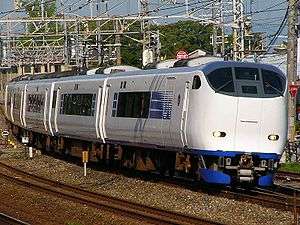
Kansai International Airport is connected only by the Sky Gate Bridge R, a road/railroad bridge to Rinku Town and the mainland. The lower railroad level of the bridge is used by two railroad operators: JR West and Nankai Electric Railway.
JR West operates the Haruka limited express train services for Kansai Airport Station from Tennōji, Shin-Ōsaka, and Kyoto Station. JR West also offers "Kansai Airport Rapid" services for Kansai Airport Station from Ōsaka, Kyōbashi Station, and several stations on the way. Various connections, such as buses, subways, trams, and other railroads, are available at each station.
Nankai operates the rapi:t, a limited express train service to Namba Station on the southern edge of downtown Osaka. Osaka Municipal Subway connections are available at Namba and Tengachaya Station.
Bus
Kansai Airport Transportation Enterprise[81] and other bus operators offer scheduled express bus services, called "Airport Limousines", for Kansai International Airport.
Parking
Two six story parking structures, called P1 and P2, are located above a railroad terminal station, while the other two level parking facilities, called P3 and P4, are situated next to "Aeroplaza", a hotel complex.
The airport is only accessible from the Sky Gate Bridge R, a part of Kansai Airport Expressway. The expressway immediately connects to Hanshin Expressways Route 5, "Wangan Route", and Hanwa Expressway.
Ferry service
In July 2007, high-speed ferry service (run by Kaijo Access Co.) began operating between Kobe Airport and KIX. The journey takes about thirty minutes.
Other facilities
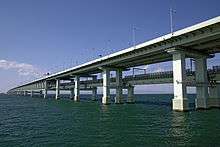
- Kansai Airport Agency Company Building (航空会社北ビル Kūkō Kaisha Kita Biru) – Houses the Kansai Airport Agency Co., Ltd. (株式会社 関西エアポートエージェンシー Kabushiki Kaisha Kansai Eapōto Ējenshī)[82][83]
- Kensetsu-to (建設棟 Kensetsu-tō)
- The head office of the Kansai International Airport Land Development Co., Ltd. (KALD, 関西国際空港用地造成株式会社 Kansai Kokusai Kūkō Yōchi Zōsei Kabushiki Kaisha) is on the fourth floor.[84]
- The Peach Aviation head office is on the fifth floor.[85][86]
- Aeroplaza (エアロプラザ Earopuraza) is located on the west side of Kansai Airport Station. It includes a hotel, restaurants, rental car counters, and other businesses[87]
- Hotel Nikko Kansai Airport (north portion of Kansai Airport)[5]
- Head office of Peach Aviation was previously located on the third floor (central portion of Kansai Airport)[88][89]
- Central power station (KEPCO) energy center, 40 MW
- Central heating and cooling plant
- Sewage disposal plant (disposing 20,000 m3 (5,300,000 US gal) per day)
- Incineration plant
- JAL Cargo import and export facilities (in southern portion)[6]
- Japan Coast Guard Kansai airport Coast Guard air base
- Japan Coast Guard Special Security Team Base
- Osaka international post office (As of 2010 carrying about 19,000 tonnes per year of international postal matter)
- Oil tanker berths (three berths) and Fuel Supply center
- Airport access bridge ("The Sky Gate Bridge R")
- As of 2011, the longest truss bridge in the world at 3,750 m (12,303 ft). The double-decker bridge consists of a lower deck devoted to rail, with the upper for road.
References
- ↑ "New Management Setup of Kansai Airport" (PDF). Kansai Airports. Kansai Airports. 2016-04-01. Retrieved 2016-04-24.
- ↑ "FedEx Opens North Pacific Regional Hub at Kansai International Airport". newswit.com. 3 July 2014. Retrieved 3 July 2014.
- ↑ "Preliminary Operational Statistics for KIX and ITM for December and Calendar Year of 2015" (PDF). New Kansai International Airport Co., Ltd. New Kansai International Airport Co., Ltd. 2015-01-20. Retrieved 2015-02-02.
- ↑ AIS Japan
- 1 2 Home. Hotel Nikko Kansai Airport. Retrieved on 23 July 2011. "Hotel Nikko Kansai Airport 1, Senshu-kuko Kita, Izumisano-shi, Osaka, 549-0001, Japan "
- 1 2 "OSAKA KANSAI (Kansai International Airport)." JAL Cargo. Retrieved on 23 July 2011. "Departure JAL Export Cargo Bldg. 1 Senshu Airport Minami, Sennan, Osaka Arrival JALKAS Import Cargo Bldg. 1 Senshu Airport Minami, Sennan, Osaka"
- ↑ "航空運送事業の許可について(Peach・Aviation 株式会社)." Ministry of Land, Infrastructure, Transport, and Tourism. 7 July 2011 (Heisei 23). Retrieved on 21 July 2011. "1.本社所在地 大阪府泉南郡田尻町泉州空港中1番地(関西空港内)"
- ↑ ANA and JAL both report massive load factor improvement on international services in 2010; ANA grows market share. anna.aero (4 August 2010). Retrieved on 16 August 2013.
- ↑ "Operational Date of Kansai International Airport" (PDF). Kansai International Airport Co., Ltd. Retrieved 19 April 2012.
- ↑ Kansai International Airport Statistics – Kansai International Airport Co., Ltd.
- ↑ Kansai International Airport 2014 summer Flight Schedules – Kansai International Airport Co., Ltd.
- ↑ Osaka Journal; Impatient City's Mission: Steal Tokyo's Thunder, New York Times, 9 December 1989.
- ↑ Some Minor Gains on Trade Conflicts, New York Times, 2 May 1987.
- ↑ US Cancels A Plan To Begin Sanctions After Japan Acts, New York Times, 27 October 1993.
- ↑ Osaka Notebook, International Herald Tribune, 24 August 1992.
- ↑ Sinking Feeling at Hong Kong Airport, International Herald Tribune, 22 January 1982.
- ↑ Osaka Journal; Huge Airport Has Its Wings Clipped, New York Times, 3 July 1991.
- ↑ U.S. Engineering Society names Kansai International Airport a Civil Engineering Monument of the Millennium – Press release from American Society of Civil Engineers
- ↑ "Kansai International Airport Land Co., Ltd - Technical Information - Approach to Settlement - Condition of the Settlement". Retrieved 4 June 2015.
- ↑ Will Fees Sink New Osaka Airport?, International Herald Tribune, 5 August 1994.
- ↑ Pride and (Ouch!) Price: The $14 Billion Airport, New York Times, 16 December 1993.
- ↑ "関空、夏季の国際線旅客5%増 台湾・東南ア顧客が増加見通し". 日本経済新聞. 19 July 2013. Retrieved 19 July 2013.
- ↑ "関空支援を国に要望 促進協、ターミナル整備など". 日本経済新聞. 22 August 2013. Retrieved 22 August 2013.
- ↑ The reason for construction of The 2nd runway– Kansai International Airport Co., Ltd.
- ↑ – Daily Yomiuri Online – Opening of new KIX runway celebrated
- ↑ "Kansai opens its Second Runway", Airports – September/October 2007 (Key Publishing), P7
- ↑ "24 hours operation from 1st September 2007" from Sankei Newspaper (Japanese) on 24 August 2007.
- ↑ KIX Terminal2. Kansai-airport.or.jp (28 October 2012). Retrieved on 16 August 2013.
- ↑ Airport wars roil Kansai region, Japan Times
- ↑ Will the U.S. Marines charge ashore at Kansai airport?, Japan Today
- ↑ 関空・伊丹統合法が成立 1兆円超す負債解消目指す, Asahi Shimbun
- ↑ 関空、国際線着陸料5%下げ LCC誘致へ10月から, Nihon Keizai Shimbun
- ↑ 新関空会社、ミャンマーの国際空港入札に参加 海外2カ所目, Nihon Keizai Shimbun
- ↑ Fujita, Junko (22 May 2015). "Orix only confirmed bidder for Kansai airport rights after more drop out". Reuters. Retrieved 14 September 2015.
- ↑ 伊藤, 正泰 (11 September 2015). "新関空会社とオリックス陣営、空港運営権の売却で大筋合意". The Nikkei. Retrieved 14 September 2015.
- ↑ Commercial offer to the fore as Kansai opens budget terminal. TheMoodieReport.com. Retrieved on 16 August 2013.
- ↑ Kansai Airport opens new terminal for low-cost carriers – AJW by The Asahi Shimbun. Ajw.asahi.com. Retrieved on 16 August 2013.
- ↑ (Japanese) :日本経済新聞. Nikkei.com. Retrieved on 16 August 2013.
- ↑ (Japanese) :日本経済新聞. Nikkei.com. Retrieved on 16 August 2013.
- ↑ Large "Ecopark" Outside Kansai Terminal 2 with Fields, "Ecofarm" and More – Airport News Japan. En.airportnews.jp (25 October 2012). Retrieved on 16 August 2013.
- ↑ "関空、新ターミナルに国際線就航へ LCC向け". 日本経済新聞. 25 November 2013. Retrieved 27 November 2013.
- ↑ "関空第3ターミナル、LCC積極誘致 駐機場を増設しやすく". 日本経済新聞. 13 December 2013. Retrieved 13 December 2013.
- ↑ "関空新ターミナル、開業1年延期 格安航空の増便不透明". 日本経済新聞. 12 July 2013. Retrieved 12 July 2013.
- ↑ "Air Busan expands Daegu - Japan service from Dec 2016". routesonline. Retrieved 22 November 2016.
- ↑ "Air New Zealand Resumes Osaka Service from Nov 2016". airlineroute. Retrieved 1 April 2016.
- ↑ "Beijing Capital Airlines Adds Jinan – Japan Routes in S16". airlineroute. Retrieved 6 April 2016.
- ↑ "Capital Airlines Adds Shenyang – Japan Routes from mid-May 2016". airlineroute. Retrieved 22 April 2016.
- ↑ "China Airlines Confirms Tainan - Osaka Launch from late-Oct 2015". Airlineroute.net. 5 June 2015. Retrieved 5 June 2015.
- ↑ "China Eastern Delays Wenzhou – Osaka Launch to May 2015". Airlineroute.net. 24 March 2015. Retrieved 24 March 2015.
- ↑ China Eastern Adds Yanji – Osaka Service from July 2015 :: Routesonline
- ↑ "China Southern Adds Guilin – Osaka Route from May 2015". airlineroute. 16 March 2015. Retrieved 16 March 2015.
- ↑ "China Southern Adds New Shanghai – Japan Routes in S16". airlineroute. Retrieved 16 February 2016.
- ↑ "China Southern Adds New Shenzhen - Japan Routes from late-July 2015". Airlineroute.net. 30 June 2015. Retrieved 30 June 2015.
- ↑ http://www.routesonline.com/news/38/airlineroute/270001/egypt-air-adds-charter-flights-to-japan-in-w16/?highlight=egypt
- ↑ "Far Eastern Air to Start Taichung – Osaka Service from mid-June 2015". Retrieved 4 June 2015.
- ↑ "Far Eastern Air Files Preliminary Taiwan – Japan Operations from July 2016". airlineroute. Retrieved 18 January 2016.
- ↑ "JAL W14 International Changes: Osaka – Los Angeles Resumes from late-March 2015". Retrieved 4 June 2015.
- ↑ "Jetstar Japan Adds Osaka – Hong Kong Service from late-Feb 2015". airlineroute. 3 December 2014. Retrieved 3 December 2014.
- ↑ "Jetstar Japan to Launch Taipei Service from late-Nov 2015". Airlineroute.net. 13 October 2015. Retrieved 13 October 2015.
- ↑ "02AUG16 Update – Jetstar Japan W16 International Changes". routesonline. Retrieved 2 August 2016.
- ↑ . 5 July 2016 http://www.japantoday.com/category/travel/view/danang-tees-up-direct-flights-from-osaka. Missing or empty
|title=(help) - ↑ "Jin Air Adds New Routes from Busan eff late-Sept 2015". Airlineroute.net. 24 August 2015. Retrieved 24 August 2015.
- ↑ "Juneyao Airlines Adds Nanjing – Osaka Route from Aug 2016". routesonline. Retrieved 17 June 2016.
- ↑ "Peach to Add Osaka – Miyazaki Route from late-August 2015". Retrieved 4 June 2015.
- ↑ "Peach adds Shanghai service from Nov 2016". routesonline. Retrieved 2 September 2016.
- ↑ "Philippine Airlines Files Preliminary Taipei – Osaka Schedule from late-June 2016". airlineroute. Retrieved 22 February 2016.
- 1 2 "Shandong Airlines Adds New Osaka Service from July 2015". Airlineroute.net. 4 June 2015. Retrieved 4 June 2015.
- ↑ "Shenzhen Airlines to Start Beijing - Osaka Flight from July 2015". Airlineroute.net. 29 April 2015. Retrieved 29 April 2015.
- ↑ "Shenzhen Airlines Expands Osaka Service in W15". Airlineroute.net. 10 November 2015. Retrieved 10 November 2015.
- ↑ Spring Airlines Expands Osaka / Nagoya Service from late-Sep 2015 :: Routesonline
- 1 2 "Spring Airlines Adds New Ibaraki / Osaka Kansai Routes from late-March 2016". airlineroute. Retrieved 1 March 2016.
- 1 2 "Spring Airlines adds new Osaka routes from Nov 2016". routesonline. Retrieved 10 November 2016.
- 1 2 3 "Spring Airlines Launches 4 New China – Osaka Routes in S15". Retrieved 4 June 2015.
- ↑ "Spring Airlines Japan plans Tokyo – Osaka flights from Sep 2016". routesonline. Retrieved 26 August 2016.
- ↑ "Tianjin Airlines Adds Dalian – Japan Routes from July 2016". routesonline. Retrieved 14 June 2016.
- ↑ "tigerair Taiwan Adds Kaohsiung - Osaka; Bangkok Service Reductions from July 2015". Airlineroute.net. 16 June 2015. Retrieved 16 June 2015.
- ↑ "Turkish Airlines ends Osaka service in Jan 2017". routesonline. Retrieved 31 October 2016.
- ↑ Tway
- ↑ "T'Way Airlines Adds New Routes to Osaka in S15". Retrieved 4 June 2015.
- ↑ China Southern launches Japanese route, Asian exports decline | Air Cargo World News. Aircargoworld.com (30 August 2012). Retrieved on 16 August 2013.
- ↑ "Kansai Airport limousine". Retrieved 4 June 2015.
- ↑ "090406a.pdf." Kansai International Airport Land Development Co., Ltd. Retrieved on 2 November 2011. "Kansai Airport Agency Company Building (4F) 1 Senshu-Kuko Kita, Izumisano, Osaka 549-0001"
- ↑ "会社情報." Kansai Airport Agency. Retrieved on 2 November 2011. "〒549-0001 大阪府泉佐野市泉州空港北1番地航空会社北ビル4F"
- ↑ "見学ホール." Kansai International Airport Land Development Co., Ltd. Retrieved on 1 November 2011. "〒549–0001 大阪府泉佐野市泉州空港北一番地 建設棟4F"
- ↑ "Privacy Policy." Peach Aviation. Retrieved on 23 July 2011. "Peach Aviation Limited Kensetsu-to 5th floor, 1-Senshukuko-kita, Izumisano-shi, Osaka, Japan 549-8585" – Japanese: "〒549-8585 大阪府泉佐野市泉州空港北一番地 建設棟5階 Peach Aviation株式会社"
- ↑ "About Us." Peach. Retrieved on 1 November 2011. "Izumisano-shi, Osaka, Japan 549-8585" Address in Japanese: "大阪府泉佐野市"
- ↑ "Airport Facilities Information." Kansai International Airport. Retrieved on 23 July 2011. ""
- ↑ "Privacy Policy." Peach Aviation. Retrieved on 23 July 2011. "Personal information desk Peach Aviation Limited Aeroplaza 3F, 1 Senshu-kuko-naka, Tajiricho, Sennan-gun, Osaka 549-8585, Japan" – Japanese: "〒549-8585 大阪府泉南郡田尻町泉州空港中1 番地エアロプラザ3F Peach Aviation株式会社 個人情報取り扱い担当行き"
- ↑ "About Us." Peach. Retrieved on 21 July 2011. "Tajiri-cho, Sennangun, Osaka, Japan" Address in Japanese: "本社所在地 大阪府泉南郡田尻町"
Further reading
- Hausler, E. and N. Sitar. "Performance of Soil Improvement Techniques in Earthquakes." (Archive) (Report in Progress) Pacific Earthquake Engineering Research Center, University of California Berkeley.
External links
| Wikimedia Commons has media related to Kansai International Airport. |
| Wikivoyage has a travel guide for Kansai International Airport. |
- (English) KIX operations website
- KIX corporate website
- KIX development website
- History of KIX
- About the project of Kansai International Airport